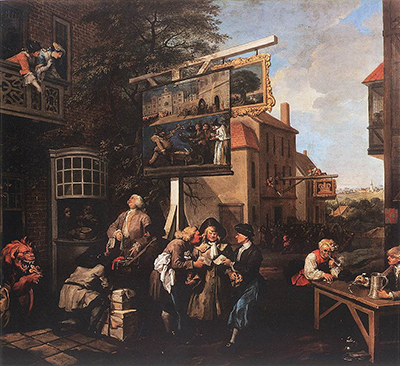Canvassing for votes is the second work in a series of four. The entire series is entitled "Humours of an Election" and is widely regarded as Hogarth's last great work.
It is loosely based on the events of the election in 1754, especially in Oxfordshire as corruption was so rife there. Hogarth may also have drawn inspiration from the poem "The humours of a country election" written in 1741. The work was originally painted in 1755 and then engraved in 1758 by Charles Grignion after Hogarth had struggled engraving the first piece in the series himself. The original pictures were all oil paintings. The image portrays opposing political parties - the Whigs and the Tories - attempting to gain votes through bribery. The inn on the left is The Royal Oak which is also the headquarters of the Tory Party.
The sign has been partially covered by an image depicting a Whig candidate as the famous "Punch" character throwing coins to voters out of a wheelbarrow and effectively buying votes. Ironic then that the Tory candidate stands directly below this sign buying trinkets with which to bribe the girls flirting with him. During this time period only men who owned property were able to vote and ballots were not secret so bribery and intimidation were both common practice. Hogarth uses satire to represent this level of corruption in his paintings. In the background a Tory mob is shown attacking the Whig headquarters which shows the extreme violence caused by such elections. In the centre foreground one man is accepting two bribes at once, one from each party.
It is argued that this is a representation of The Choice of Hercules, except the man representing Hercules in this situation does not have to choose, he is able to take both bribes. Near the end of his life Hogarth became disillusioned with many of his ideals, both in life and art. Many illegal and morally corrupt behaviors are displayed in this image which supports Hogarth's pessimism in humanity. Alongside the violence and bribery, behaviours such as drunkenness, greed (gorging on too much food) and betrayal are shown. Through this painting Hogarth aimed not only to show the corruption of democracy at the time, but also the stupidity and selfishness of humanity as a whole.




